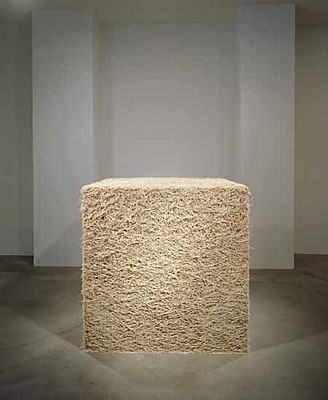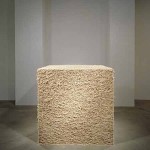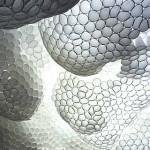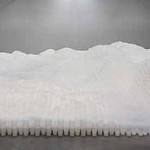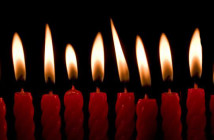TARA DONOVAN @ THE ICA
The first thing I noticed upon entering the ICA's West Gallery was the abundance of security guards hovering around the room, their teeth gritted nervously. While this might seem intimidating to the average viewer, it is actually a testament to the fascinatingly improbable nature of Tara Donovan's sculptures. All of her pieces, and especially the three untitled cubes that greet viewers at the gallery entrance, inspire such a sense of disbelief that one can hardly resist reaching out and touching them.
Of course, as fragile as Donovan's sculptures can be, this would be a disaster. Hence, the army of stressed out guards.
Regular visitors to the ICA will already be familiar with Donovan's cube of pins, its precariousness both confounding and thrilling. Nearby is a similar cube, made of toothpicks, that is equally amazing and yet, for me, is not quite as provocative as the pins. Perhaps it is the implication of pain, of being stuck with those pins, that makes one cube more dangerous than the other.
The third of the cubes, made of glass plates that have been shattered by Donovan, is fascinating in a different way. While the pins and toothpicks were added over time to make their cubes, and their shapes feel somewhat sedimentary, the glass cube is the product of destruction. Donovan has reduced once-solid glass plates to shards, no longer capable of serving their intended purpose. Any pin or toothpick removed from those cubes could resume its existence as an ordinary object, but the glass fragments are only the remnants of the former plates. I'm not sure what it is about this difference that appeals to me, but looking over the exhibition catalog I am reminded that this is the only work in the show created by a destructive process, and while many of the everyday items employed by Donovan may not be able to be restored to their original state, the glass cube is the only piece in which she has deliberately destroyed her material.
One of the great pieces in this exhibition is Untitled (Plastic Cups) in which Donovan has created an undulating landscape made entirely of clear plastic cups. Like a frozen tundra, the cups climb skyward in peaks that collapse under their own weight, or recede to valleys that darken as the floor becomes visible through the plastic. My only disappointment with the piece is that, having seen the version installed at Pace Wildenstein in 2006, the ICA's iteration feels somewhat underwhelming. Donovan is very careful to create her pieces to the specifications of the spaces she uses, and the piece is very elegant, but it raises an interesting point about the specificity of experience when works change in response to context.
Here I think of Martha Buskirk's book The Contingent Object of Contemporary Art, in which she states the concern quite well. "Over a work's history, decisions about how it will be presented necessarily determine the spectator's experiential understanding of it. In the case of work made from unfixed or changeable elements, interpretation is not simply a matter of a possibly varied response to an essentially stable physical object; instead, a prior stage of interpretation can have dramatic implications for the configuration of the object to be perceived."
Many of Donovan's pieces seem to be pushing the boundaries of this question. Viewers who have seen previous iterations of her sculptures will be inclined to compare the experiences, while the initial viewing of many works inspire questions about how they will exist in the future. Unlike more traditional art forms, such as paintings or bronzes, Donovan's pieces cannot just be crated up and put in storage. So what happens to Bluffs, her beautiful stalagmites of buttons, when the exhibition ends? Are they placed in a box and set aside? When a crated painting is opened, the painting looks the same is it did when it was sealed, but Donovan's buttons will never be presented in this exact configuration ever again.
Overhearing conversations between ICA guards and guests, one of the most common threads was the amount of work contributed by ICA staff in creating the artwork. This impermanence, the fact that these sculptures exist only for this installation, is one of the most strikingly fascinating parts of Donovan's work. In the context of a museum, the fact that each piece had to be meticulously created inspires a sense that the experience is unique and personal to the viewer. I say that the work was created for this exhibition, rather than re-created, because Donovan seems to challenge us with the very nature of the works' creation and its specificity to site and time. The constraints of the art market probably compel her to talk of Untitled (Plastic Cups) as the same work of art shown two years ago, but having seen both installations I know they are not.
There are seventeen works in "Look Closer," and each challenges and delights in a different way. Haze is a stunning visual experience, made by stacking clear plastic drinking straws along an entire gallery wall. They catch the light and trick the eye in a way that is both indescribable and amazing. Not content to merely create scapes on the floors and walls, Untitled (Styrofoam Cups) bulges from the ceiling, while the Scotch tape haze of Nebulous seems to hover just above the floor.
Tara Donovan has created a delightful exhibition at the ICA, the kind in which viewers often ask How did she...? before being warned by a guard not to touch the work. Donovan's exploration of everyday materials, and the creation of experiences that surprise and confound, are the success of the show. Her work engages some of the toughest questions posed by artists in recent years, and yet does so with a light touch and a prevailing sense of beauty.
- Tara Donovan, Untitled (Toothpicks), 1996.
- Tara Donovan, Untitled (Styrofoam Cups), 2004/2008.
- Tara Donovan, Untitled (Plastic Cups), 2006/2008.
"Tara Donovan: Look Closer" is on view October 10, 2008 - January 4, 2009 at the Institute of Contemporary Art.
All images are courtesy of the ICA.

